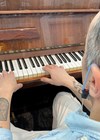Here, we discover the profound exploration of deafness through art by Anita Ford. Her Cacophony series delves into the challenges of communication and isolation.
Anita Ford was a prolific printmaker and painter. She studied at Loughborough College of Art, obtaining a Dip AD first-class honours degree in fine art, following which she took up an Italian state scholarship to study at the Academia di Belle Arti in Venice. She set up print studios in Bologna and Verona and, in her 50 years as an artist, exhibited and sold extensively, both internationally and in the UK.

Nearing the end of her life, she became increasingly affected by deafness and felt a need to face and come to terms with this condition that was causing her so much stress and frustration. How? Well, through her art of course, probing further into something which for her was, by its nature, dark and personal. Art is known as a good way of addressing difficult thoughts, decisions and trauma, as of course is writing.
“Becoming deaf, my hearing has deteriorated to the point where conversation can sometimes be difficult. I am learning to lip read. Mouths have become more than a means of aural communication or emotional countenance; they are visual expressions in the most basic sense.
I watch words. I work hard to hear, make mistakes, get tired. As the population ages, there are a lot of us about, in isolation whilst surrounded by people, observing mankind through a veil of miscommunications, anxious, apologetic. There are words and phrases used constantly...
‘Sorry?’ (I can’t hear you); ‘Please don’t turn away from me’ (I need to see your lips); ‘Look at me please’ (I need to see your lips); ‘Don’t walk away from me’ (I need to see your lips!!)
These are just a few of the practical requests that I realised were holding in their words huge emotional content which went much further than hearing loss. The work I’m engaged in emerged from a growing disability but has developed into the expression of a more universal hunger, the need to communicate under stress, and the difficulty in doing that. We’ve all been there, when words fail us, when you can’t hear your thoughts, your mind goes blank.
You try to find the right words but there is just cacophony.’
There are similarities running through the series of this work. They are all black or monochrome with just a little red. There is no compromise here – let’s hit the problem face to face. Anita was nothing if not resolute. Holes punched in the card allow glimpses of letters, a reference to typewriter keys or the perhaps perforated holes in a dated telephone or headphone.
There are the letters themselves. A reference to certain boardgames, a lighter context; it is not all doom and gloom. Anita did not lose her humour.
"Most have a presence of some sort of grid work which can be seen as representing her determination to organise, to rationalise something that is amorphous"
The background is fuzzy in varying degrees, sometimes completely obliterating the letters. Is this the background noise that ranges from almost unbearable tinnitus, through the sound of coexisting conversation, to the low but ever-present noise pollution of the city?
Most have a presence of some sort of grid work which can be seen as representing her determination to organise, to rationalise something that is amorphous.

‘Fading Words’. Framed size: 78 x 55cm.

‘Untitled One’. Framed size: 60 x 45cm.

(Triptych) ‘Concentration’, ‘To Comprehend’ and ‘Layers of Opinion’. Framed size each: 76 x 31cm.

‘What one should do in the circumstances’. Framed size: 46 x 42cm.

‘The Difficulty comes with the difference’. Framed size: 46 x 42cm.

‘I look for the differences’. Framed size: 46 x 42cm.

(Triptych) ‘Quiet message one’, ‘Quiet message two’ and ‘Quiet message three’. Framed size each: 80 x 80cm.
The Cacophony collection was first exhibited with Saatchi Art at the Other Art Fair in 2016 in London. Anita died in 2018. Most of this body of work is in need of a home. It is available freely, but placement is probably best suited to any establishment with a connection to hearing loss. It would be appreciated if for any work taken, a donation is made to a hearing charity from which no deductions will be made. If you are interested in displaying the Cacophony collection, or know of a place that might be, please contact Anita’s husband, Alfred Huckett at alfredhuckett@hotmail.com.
You can find more of Anita Ford’s art on her website at: www.anitaford-art.co.uk








